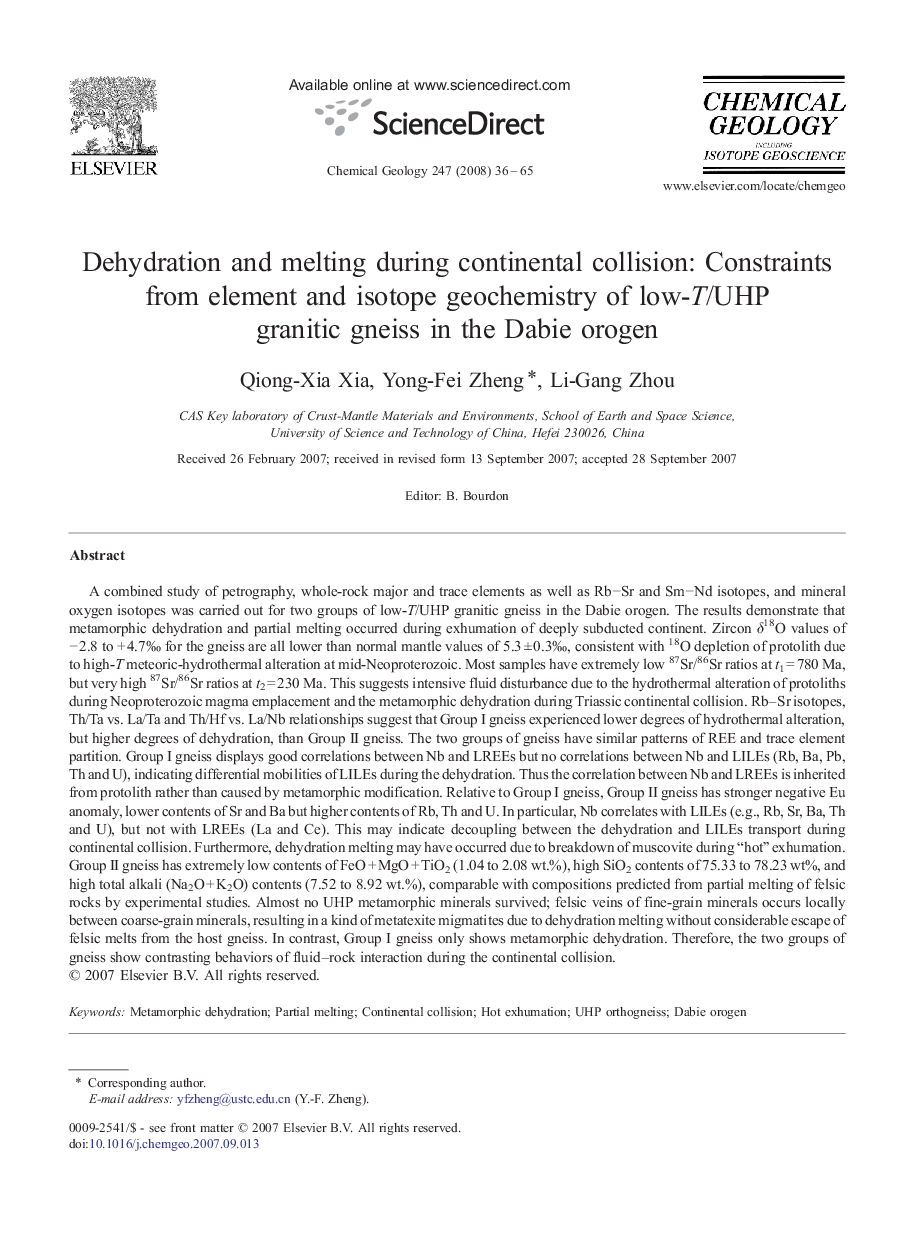| کد مقاله | کد نشریه | سال انتشار | مقاله انگلیسی | نسخه تمام متن |
|---|---|---|---|---|
| 4700704 | 1637736 | 2008 | 30 صفحه PDF | دانلود رایگان |

A combined study of petrography, whole-rock major and trace elements as well as Rb−Sr and Sm−Nd isotopes, and mineral oxygen isotopes was carried out for two groups of low-T/UHP granitic gneiss in the Dabie orogen. The results demonstrate that metamorphic dehydration and partial melting occurred during exhumation of deeply subducted continent. Zircon δ18O values of − 2.8 to + 4.7‰ for the gneiss are all lower than normal mantle values of 5.3 ± 0.3‰, consistent with 18O depletion of protolith due to high-T meteoric-hydrothermal alteration at mid-Neoproterozoic. Most samples have extremely low 87Sr/86Sr ratios at t1 = 780 Ma, but very high 87Sr/86Sr ratios at t2 = 230 Ma. This suggests intensive fluid disturbance due to the hydrothermal alteration of protoliths during Neoproterozoic magma emplacement and the metamorphic dehydration during Triassic continental collision. Rb–Sr isotopes, Th/Ta vs. La/Ta and Th/Hf vs. La/Nb relationships suggest that Group I gneiss experienced lower degrees of hydrothermal alteration, but higher degrees of dehydration, than Group II gneiss. The two groups of gneiss have similar patterns of REE and trace element partition. Group I gneiss displays good correlations between Nb and LREEs but no correlations between Nb and LILEs (Rb, Ba, Pb, Th and U), indicating differential mobilities of LILEs during the dehydration. Thus the correlation between Nb and LREEs is inherited from protolith rather than caused by metamorphic modification. Relative to Group I gneiss, Group II gneiss has stronger negative Eu anomaly, lower contents of Sr and Ba but higher contents of Rb, Th and U. In particular, Nb correlates with LILEs (e.g., Rb, Sr, Ba, Th and U), but not with LREEs (La and Ce). This may indicate decoupling between the dehydration and LILEs transport during continental collision. Furthermore, dehydration melting may have occurred due to breakdown of muscovite during “hot” exhumation. Group II gneiss has extremely low contents of FeO + MgO + TiO2 (1.04 to 2.08 wt.%), high SiO2 contents of 75.33 to 78.23 wt%, and high total alkali (Na2O + K2O) contents (7.52 to 8.92 wt.%), comparable with compositions predicted from partial melting of felsic rocks by experimental studies. Almost no UHP metamorphic minerals survived; felsic veins of fine-grain minerals occurs locally between coarse-grain minerals, resulting in a kind of metatexite migmatites due to dehydration melting without considerable escape of felsic melts from the host gneiss. In contrast, Group I gneiss only shows metamorphic dehydration. Therefore, the two groups of gneiss show contrasting behaviors of fluid–rock interaction during the continental collision.
Journal: Chemical Geology - Volume 247, Issues 1–2, 15 January 2008, Pages 36–65